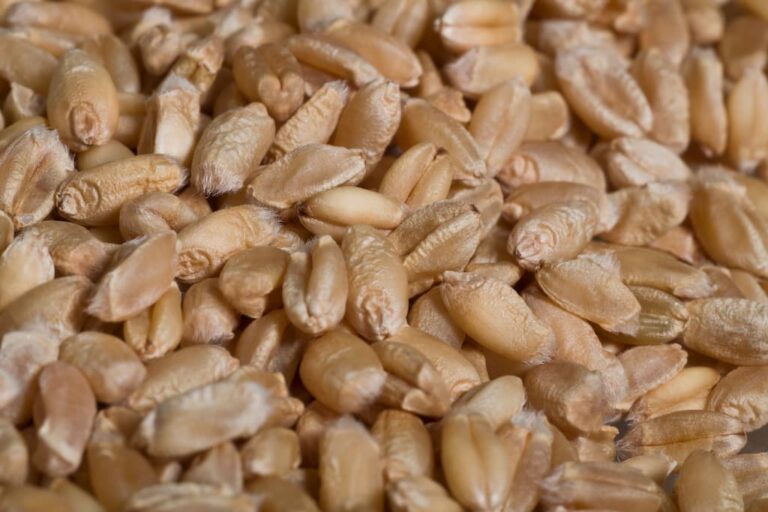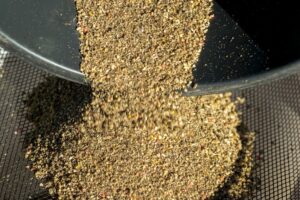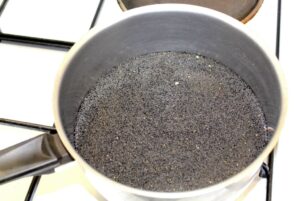Vegetable bait : wheat grains

Wheat, well-known as a staple cereal in human nutrition, also plays a surprising role in the fishing world.
Wheat attracts with its small size and high starch content is highly valued for its effectiveness as bait, especially for bottom feeders and panfish such as Bream and Roach.

Key Takeaways
- Due to its small size and high starch content, wheat is a popular bait in match fishing. It attracts white fish, notably bream and roach.
- For optimal effectiveness, wheat grains must be soaked and then cooked until slightly fermented before being stored cool or frozen.
- Before fishing, it is crucial to bait the area with wheat to create a food carpet that attracts fish.
- The size of the wheat grains should be adapted to the type of fish targeted, with smaller grains for Roach and larger grains for Carp.
- Baiting wheat on the hook requires skill, and a patient approach during fishing is advised to ensure effective striking.
What is wheat?
The term “wheat” refers to several cereals of the Triticum genus. It appeared in the 11th century to designate all cereals. These annual plants belonging to the grass family are cultivated in many countries. The word “wheat” is also used to refer to the grain (caryopsis) produced by these plants.
Wheat, containing about 10% protein and rich in starch, is an essential element of the diet in the West and the Middle East.
Wheat and its use in fishing
Wheat is an effective bait for attracting bottom feeders and panfish and keeping them in the fishing zone. However, it is essential to use it sparingly, especially during the high season. Belonging to the cereal family, wheat is a highly prized grain for baiting fish. Although it has a low protein content of about 10%, it is rich in starch. Its small size encourages feeding competition, making it a popular choice among match fishermen. For those who prefer, there are ready-made mixes (spod mix) available on the market, both flavored and natural.
Preparation and conservation of wheat for fishing
Preparation of wheat grains
To prepare wheat grains for fishing, it is recommended to soak them for two hours in very hot water, then rinse them. This helps to remove any potential pesticides used.
It is necessary to soak them overnight in hot water, then cook them until they almost burst. Then, they should be rinsed and placed in room-temperature water.
This preparation method achieves a slight fermentation, which is stopped by storing the wheat cool. Slightly fermented wheat is much better and will serve for baiting and hooking. Proper preparation is essential to take full advantage of this grain.
Conservation of cooked wheat
Once cooked, the wheat can be kept cool in an airtight container or frozen for later use.
Fishing with wheat
Preparing the fishing spot
Before starting a session of fishing with cooked wheat, it is essential to properly prepare the spot by baiting the area with wheat to attract fish. The noise of the distribution and the carpet that forms will pique the interest of all the panfish and bottom feeders in the area, particularly bream and roach.
The size of the grains
It is crucial to choose the size of the wheat grains according to the fish one wishes to catch. For Roach, smaller grains will be more suitable, while for Carp, larger grains cooked a little longer will be preferable. Bream is also a fish that willingly feeds on wheat.
How to bait a grain of wheat?
To bait a grain of wheat, it is recommended to thread it onto the hook using a baiting needle. It is also possible to thread it directly onto the hook. It is essential to ensure the wheat is well secured on the hook to prevent it from detaching during casting. When fishing with grain, it is advised to be patient and wait for the fish to bite before striking. It is important to note that overcooked wheat tends to detach easily.
Hair rigging with wheat is a widespread technique among carp fishermen. For this method, it is recommended to use larger wheat grains and cook them a little less long to make them firmer.
Then, they should be threaded onto the hair rig using a baiting needle. This technique allows the wheat to be presented naturally and attractively to Carp. It is better to ensure the grain is well secured on the hair rig to prevent it from detaching during casting.



